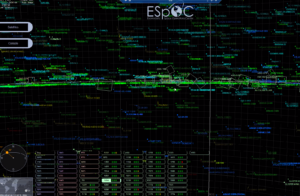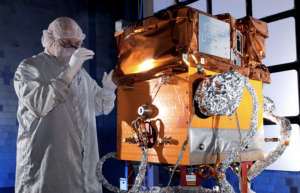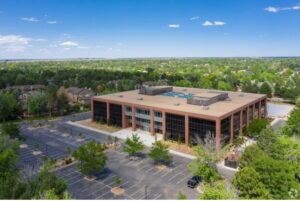SpaceX Crew 5 mission set to lift off for International Space Station
Wednesday, 05 October 2022 03:27 NASA and Space X's Crew 5 mission is set to blast off for the International Space Station on Wednesday.
Hurricane Ian previously delayed the Crew 5 mission, along with the launch of the Artemis 1 moon test flight, but the Crew 5 launch is set for noon EDT.
The crew of four, which includes the first female commander and first Russian cosmonaut to fly on a SpaceX mission, arrived a
NASA and Space X's Crew 5 mission is set to blast off for the International Space Station on Wednesday.
Hurricane Ian previously delayed the Crew 5 mission, along with the launch of the Artemis 1 moon test flight, but the Crew 5 launch is set for noon EDT.
The crew of four, which includes the first female commander and first Russian cosmonaut to fly on a SpaceX mission, arrived a Firefly Aerospace reaches orbit and deploys customer payloads with its Alpha Rocket
Wednesday, 05 October 2022 03:27 Firefly Aerospace, a new space leader in launch, spacecraft, and in-space services, announced that its Alpha FLTA002 mission successfully reached orbit and deployed customer payloads, lifting off on October 1 at 12:01am PST from Vandenberg Space Force Base in California.
With the success of this mission, Firefly is now the first company to launch and reach orbit from US soil in only its s
Firefly Aerospace, a new space leader in launch, spacecraft, and in-space services, announced that its Alpha FLTA002 mission successfully reached orbit and deployed customer payloads, lifting off on October 1 at 12:01am PST from Vandenberg Space Force Base in California.
With the success of this mission, Firefly is now the first company to launch and reach orbit from US soil in only its s SOAR Telescope catches Dimorphos's expanding comet-like tail after DART impact
Wednesday, 05 October 2022 03:27 NASA's Double Asteroid Redirection Test (DART) spacecraft intentionally crashed into Dimorphos, the asteroid moonlet in the double-asteroid system of Didymos, on Monday 26 September 2022. This was the first planetary defense test in which an impact of a spacecraft attempted to modify the orbit of an asteroid.
Two days after DART's impact, astronomers Teddy Kareta (Lowell Observatory) and M
NASA's Double Asteroid Redirection Test (DART) spacecraft intentionally crashed into Dimorphos, the asteroid moonlet in the double-asteroid system of Didymos, on Monday 26 September 2022. This was the first planetary defense test in which an impact of a spacecraft attempted to modify the orbit of an asteroid.
Two days after DART's impact, astronomers Teddy Kareta (Lowell Observatory) and M Curiosity targets Canaima bedrock for sampling: Sol 3612
Wednesday, 05 October 2022 03:27 Over the weekend, Curiosity took compositional measurements of the "Canaima" bedrock target in order to determine if the target merits collecting drilled sample. Concurrently, the engineering team took preload measurements to determine the stability of the rock for drilling. This morning the science and engineering teams reviewed the information downlinked and were excited to approve moving forw
Over the weekend, Curiosity took compositional measurements of the "Canaima" bedrock target in order to determine if the target merits collecting drilled sample. Concurrently, the engineering team took preload measurements to determine the stability of the rock for drilling. This morning the science and engineering teams reviewed the information downlinked and were excited to approve moving forw Laughing gas in space could mean life
Wednesday, 05 October 2022 03:27 Scientists at UC Riverside are suggesting something is missing from the typical roster of chemicals that astrobiologists use to search for life on planets around other stars - laughing gas.
Chemical compounds in a planet's atmosphere that could indicate life, called biosignatures, typically include gases found in abundance in Earth's atmosphere today.
"There's been a lot of thought p
Scientists at UC Riverside are suggesting something is missing from the typical roster of chemicals that astrobiologists use to search for life on planets around other stars - laughing gas.
Chemical compounds in a planet's atmosphere that could indicate life, called biosignatures, typically include gases found in abundance in Earth's atmosphere today.
"There's been a lot of thought p AE Industrial Partners makes significant investment in York Space Systems
Wednesday, 05 October 2022 03:27 AE Industrial Partners, LP ("AEI"), a leader in space investing and a private equity firm specializing in aerospace, defense and government services, space, power and utility services, and specialty industrial markets, announced that it has agreed to acquire a majority stake in York Space Systems , an independent provider of small satellites, satellite components and turnkey mission operations.
AE Industrial Partners, LP ("AEI"), a leader in space investing and a private equity firm specializing in aerospace, defense and government services, space, power and utility services, and specialty industrial markets, announced that it has agreed to acquire a majority stake in York Space Systems , an independent provider of small satellites, satellite components and turnkey mission operations. ViaSat-3 achieves flight configuration
Wednesday, 05 October 2022 03:27 Viasat Inc. (NASDAQ: VSAT) has reported the completion of the integration of the first ViaSat-3 satellite, marking the first time the satellite is in its flight configuration.
he ViaSat-3 satellite has now entered the mechanical environmental testing process, simulating the vibration and acoustic environments that the satellite will experience during the launch and early transfer orbit pha
Viasat Inc. (NASDAQ: VSAT) has reported the completion of the integration of the first ViaSat-3 satellite, marking the first time the satellite is in its flight configuration.
he ViaSat-3 satellite has now entered the mechanical environmental testing process, simulating the vibration and acoustic environments that the satellite will experience during the launch and early transfer orbit pha Satellogic signs 3 year deal with Albania to access dedicated satellite constellation
Wednesday, 05 October 2022 03:27 Satellogic Inc. (NASDAQ: SATL), a leader in sub-meter resolution Earth Observation ("EO") data collection, announced that it has reached a three-year agreement with the Government of Albania to develop a Dedicated Satellite Constellation. This unique program derives from Satellogic's Constellation-as-a-Service model and will provide Albania with responsive satellite imagery capabilities across i
Satellogic Inc. (NASDAQ: SATL), a leader in sub-meter resolution Earth Observation ("EO") data collection, announced that it has reached a three-year agreement with the Government of Albania to develop a Dedicated Satellite Constellation. This unique program derives from Satellogic's Constellation-as-a-Service model and will provide Albania with responsive satellite imagery capabilities across i John Deere announces Request for Proposals for satellite communications opportunity
Wednesday, 05 October 2022 03:27 Deere and Company (NYSE: DE) announced it has issued a satellite communications (SATCOM)-focused request for proposals to secure a cutting-edge solution that will further connect its fleet of intelligent machines. This will enhance the satellite connectivity that Deere is already delivering to its customers today, and is a critical step in the company's commitment to creating value for farmers a
Deere and Company (NYSE: DE) announced it has issued a satellite communications (SATCOM)-focused request for proposals to secure a cutting-edge solution that will further connect its fleet of intelligent machines. This will enhance the satellite connectivity that Deere is already delivering to its customers today, and is a critical step in the company's commitment to creating value for farmers a Concert Technologies to use C6 Launch to launch its satellites
Wednesday, 05 October 2022 03:27 Concert Technologies and C6 Launch signed a non exclusive launch services agreement. Under the agreement, C6 Launch will provide launch services for several of Concert's satellites to low Earth orbit from Alcantara Space Center in 2025 and 2026 with subsequent missions to maintain and expand Concert's constellation of high-resolution imaging systems. These missions will be significant milestones
Concert Technologies and C6 Launch signed a non exclusive launch services agreement. Under the agreement, C6 Launch will provide launch services for several of Concert's satellites to low Earth orbit from Alcantara Space Center in 2025 and 2026 with subsequent missions to maintain and expand Concert's constellation of high-resolution imaging systems. These missions will be significant milestones China begins search for fourth astronaut generation
Wednesday, 05 October 2022 03:27 China has recently started recruiting the country's fourth generation of astronauts, and the search has opened to people in Hong Kong and Macao for the first time, the China Manned Space Agency said.
The agency said in a news release on Sunday afternoon experts will pick 12 to 14 candidates for the new generation. Among them, seven to eight will be spacecraft pilots, three to four will be
China has recently started recruiting the country's fourth generation of astronauts, and the search has opened to people in Hong Kong and Macao for the first time, the China Manned Space Agency said.
The agency said in a news release on Sunday afternoon experts will pick 12 to 14 candidates for the new generation. Among them, seven to eight will be spacecraft pilots, three to four will be Space Force in discussions with industry on future market for space surveillance data
Tuesday, 04 October 2022 20:49
Companies in the space domain awareness market are eager to work with the Space Force but need a clearer picture of future demand
The post Space Force in discussions with industry on future market for space surveillance data appeared first on SpaceNews.
Ball Aerospace wins $176 million contract to build and operate 10 satellites for Space Development Agency
Tuesday, 04 October 2022 20:16
The Space Development Agency announced Oct. 4 it awarded Ball Aerospace a $176 million contract to build, operate and secure launch services for 10 experimental satellites.
The post Ball Aerospace wins $176 million contract to build and operate 10 satellites for Space Development Agency appeared first on SpaceNews.
Testing: Space-bound US-European water mission passes finals
Tuesday, 04 October 2022 19:51
Before any NASA mission is launched, the spacecraft goes through weeks of harsh treatment. It's strapped to a big table that shakes as hard as the pounding of a rocket launch. It's bombarded with louder noise than a stadium rock concert. It's frozen, baked, and irradiated in a vacuum chamber that simulates the extremes of space. The Surface Water and Ocean Topography mission (SWOT), a collaborative U.S.-French mission to monitor all the water on Earth's surface, has passed these major tests. Now, except for a few final checks, SWOT is ready for its December launch.
Some of SWOT's engineers at NASA's Jet Propulsion Laboratory in Southern California have invested almost a decade in designing, building, and assembling this complex mission. Watching the instruments they've labored over go through the latest round of tests has been stressful, but the team has taken the process in stride.
AEI claims majority stake in York Space Systems
Tuesday, 04 October 2022 19:26
AE Industrial Partners announced plans Oct. 4 to acquire a majority stake in York Space Systems, a small satellite manufacturer and turnkey mission operator based in Denver.
The post AEI claims majority stake in York Space Systems appeared first on SpaceNews.

